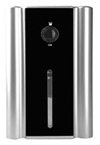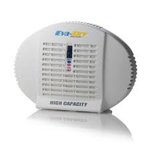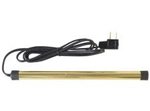Best Mini Dehumidifier
Reviews and Ratings
Article Summary
A mini dehumidifier; small, quiet, cheap to run. Seems like a great idea but, is it the best dehumidifier to use in a room, even a small room? If you search the web for consumer reviews you will find plenty that recommend these small appliances as ideal for home use. In my view they are ideal, but for closets or gun safes not for room sized areas.
In this article we'll look at the three types of mini dehumidifier, examine their strengths and weaknesses and compare them. I will suggest some uses to which you might put a unit of this type and, more importantly, explain why I think these appliances may be unsuitable for some other applications for which they are often recommended by sellers.
Types of Mini Dehumidifier
There are three types of mini dehumidifier; the thermo-electric, the rechargeable and the heated rod. We'll take a look at each in turn.
Thermo-Electric Mini Dehumidifier
The thermo-electric type is a true mini dehumidifier and differs from a typical portable in only three ways.
- It is smaller
- It has a much lower water extraction capacity
- It does not have a compressor

Unlike a standard portable a thermo-electric model does not use a compressor. Instead it makes use of the "Peltier Process". This process, named after the man who discovered it, passes electricity through a panel made of two layers of different material. For reasons it isn't essential to understand the electricity flow transfers heat from one material to the other, heating one side and cooling the other. The water vapor condenses, of course, on the cool side.
Like a conventional portable a thermo-electric mini dehumidifier needs a fan to create an air flow to and from the unit and a water collection tray to catch the condensate. It also needs a permanent power supply and must be connected to an electric socket while in use.
The advantages of the Peltier Process are that it allows the appliance to be smaller and the absence of a compressor makes it quieter.
The disadvantages are that it is less energy efficient than a portable and has a very low water extraction capacity, typically less than two pints per day and in many cases less than one pint.
If we bear in mind that the every day activities of a family of four people, cooking, cleaning, bathing, washing clothes and dishes, drying clothes, breathing and perspiring for example, will produce an estimated three gallons of water vapor per day, a water extraction capacity of less than two pints, let alone less than one pint, per day barely registers.
To put that in sharper perspective, if your house has a modest total floor area of 1000 square feet it takes only four to six pints of water vapor to raise the relative humidity in the house from 15% to 60%!
The case against the thermo-electric mini dehumidifier rests. It is clearly not the best type for home use and will not control humidity in any space larger than a closet, regardless of what is written in many "reviews".
In fact I do not recommend this type even for closets, even though it would be effective. My objections are its relatively high price, its poor energy efficiency and the need for a power cable to be attached when in use, a serious disadvantage in a closet.
Rechargeable Mini Dehumidifier
A rechargeable mini dehumidifier is very different from either a portable or a thermo-electric model. It consists of a plastic case containing silica gel crystals. The crystals absorb water from the air and are sometimes referred to as desiccant crystals. The rechargeable type has a panel which changes color, usually from blue to red, when the crystals are saturated.

To "reactivate", or dry, the crystals the appliance is plugged into an electric socket for eight to ten hours, just like a cell phone. The unit will normally need to be recharged every four to six weeks.
The advantages of the rechargeable type are its small size, silent operation (it has no moving parts), long life (up to ten years), simple, safe and clean operation and the absence of a permanently attached power cable.
The sole disadvantage is its very low water extraction rate.
This unit is usually recommended for use in a closet, a car, a gun safe or for use in other, small confined spaces. It is eminently suitable for these applications although more than one may be needed in a car or a larger closet. I am happy to recommend this type for these purposes. At around $25 each this type represents good value for money.
Some reviews suggest that a rechargeable model is suitable for use in a boat or an RV. It is not. Rechargeable units are simply not powerful enough for areas such as these.
Heated Rod Mini Dehumidifier
The heated rod is, strictly speaking, not a dehumidifier at all. It is a metal rod which is heated to a temperature just hot enough to make it uncomfortable to hold in an unprotected hand but far less hot than to be a fire risk.

The rod is placed on the floor of a small, enclosed space, and heats the air. The heated air will hold more water than cooler air so the relative humidity is lowered, although no water is extracted. Mounting the rod on the floor creates a circulation of air, by convection, which also helps to prevent condensation.
The advantages of a heated rod are that it is small, and an economical way of protecting the contents of a storage container from condensation when that container is itself located in a cool area, typically in a basement.
The disadvantage is that a heated rod needs a permanently attached power cable.
Heated rods are very popular with gun owners for use in gun safes. Gun safes are frequently kept in basements and other cool areas and contain firearms made from steel that are worth hundreds, even thousands of dollars.
They are so popular that many gun safes come with a pre-drilled hole to take the power cable, getting over the sole disadvantage of this type.
I have no difficulty in recommending this type for a gun safe, any other safe, a tool storage cabinet or any similar item.
Some reviews recommend the heated rod for use in a closet. While it will be effective the power cable is a disadvantage in this type of application and my own preference would be for one or more rechargeable units.
The heated rod mini dehumidifier is reliable, long lasting and relatively inexpensive so represents good value for money.
Although some mini dehumidifier reviews recommend the heated rod for use in a boat I cannot endorse that recommendation. There are more economical ways to heat a boat, if that is your preference, and a suitable portable will be as effective as, and much more economical than, heating.
Search our Site
Frequently Asked Questions
If you have a question why not try ourFAQs Page
Ask a Question
If you can't find the answer you need we will reply to your question here. Just type your question into the form on our
Ask a Question Page
Make a Comment
If you would like to comment on our site, to tell us we've done a good job or to suggest improvements, please click on
Visitor Comments






